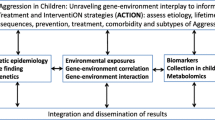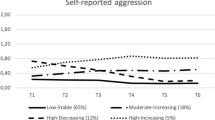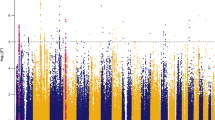Abstract
Aggressive Behavior (AGG) and Rule-Breaking Behavior (RB) are two of the eight CBCL syndromes. The phenotypic correlation between AGG and RB ranges from .48 to .76, and varies depending on the rater and the sex of the child. Prevalence of AGG and RB (i.e., T ≥ 67) is in the range of 6%–7% in both boys and girls. Fifty percent to 60% of the children who are deviant on AGG are also deviant on RB and vice versa. Why so many children show problem behavior in the clinical range for both syndromes is unclear. This co-occurrence could be due to genetic factors influencing both traits, to environmental factors influencing both traits, or to both. The purpose of this study is to use a genetically informative sample to estimate genetic and environmental influences on AGG and RB and to investigate the etiology of the co-occurrence of both behaviors. We do this using multiple informants to take into account underlying sources of parental agreement and disagreement in ratings of their offspring. To this end, mother and father ratings of AGG and RB were collected by using the Child Behavior Checklist in a large sample of 12-year-old twins. Parental agreement is represented by an interparent correlation in the range of .53–.76, depending on phenotype (AGG or RB) and sex of the child. Genetic influences account for 79% and 69% of the individual differences in RB and AGG behavior (defined as AGG and RB on which both parents do agree) in boys. In girls 56% and 72% of the variance in RB and AGG are accounted for by genetic factors. Shared environmental influences are significant for RB in girls only, explaining 23% of the total variance. Eighty percent of the covariance between AGG and RB, similarly assessed by both parents, can be explained by genetic influences. So, co-occurrence in AGG and RB is mainly caused by a common set of genes. Parental disagreement seems to be a combination of so-called rater bias and of parental specific views.
Similar content being viewed by others
References
Achenbach, T. M. (1991). Manual for the Child Behavior Checklist/4-18 and 1991 Profile. Burlington, VT: University of Vermont, Department of Psychiatry.
Achenbach, T. M., and Rescorla, L. A. (2000). Manual for ASEBA Preschool Forms & Profiles. Burlington, VT: University of Vermont, Research Center for Children, Youth, & Families.
Achenbach, T. M., and Ruffle, T. M. (2000). The Child Behavior Checklist and related forms for assessing behavioral/emotional problems and competencies. Pediatr. Rev. 21:265-271.
Achenbach, T. M., McConaughy, S. H., and Howell, C. T. (1987a). Child/adolescent behavioral and emotional problems: Implications of cross-informant correlations for situational specificity. Psychol. Bull. 101:213-232.
Achenbach, T. M., Verhulst, F. C., Baron, G. D., and Althaus, M. (1987b). A comparison of syndromes derived from the Child Behavior Checklist for American and Dutch Boys aged 6–11 and 12–16. J. Child Psychol. Psychiatry 28:437-453.
Bartels, M., Boomsma, D. I., Rietveld, M. J. H., van Beijsterveldt, C. E. M., Hudziak, J. J., and van den Oord, E. J. C. G. (2003a). Disentangling genetic, environmental, and rater effects on internalizing and externalizing problem behavior in 10-year-old twins. Psychol. Med. (under revision).
Bartels, M., Hudziak, J. J., Boomsma, D. I., Rietveld, M. J. H., Van Beijsterveldt, C. E. M., and van den Oord, E. J. C. G. (2003b). A study of parent ratings of internalizing and externalizing problem behavior in 12-year-old twins. J. Am. Acad. Child Adolesc. Psychiatry (in press).
Bartels, M., Boomsma, D. I., Hudziak, J. J., Rietveld, M. J. H., van Beijsterveldt, C. E. M., and van den Oord, E. J. C. G. (2003c). A longitudinal twin model for multiple raters: Illustrating the use of genetically informative designs for studying psychological data. Psychol. Methods (submitted).
Boomsma, D. I. (1998). Twin registers in Europe: An overview. Twin Res. 1:34-51.
Boomsma, D. I. (2002). Classical twin studies and beyond. Nat. Rev. Genet. 3:872-882.
Boomsma, D. I., Orlebeke, J. F., and Van Baal, G. C. M. (1992). The Dutch twin register: Growth data on weight and height. Behav. Genet. 22:247-251.
Boomsma, D. I., Vink, J. M., van Beijsterveldt, C. E. M., de Geus, E. J. C., Beem, A. L., Mulder, E. J. C. M., Riese, H., Willemsen, A. H. M., Bartels, M., van den Berg, M., Derks, E. M., de Graaff, S. C., Kupper, H. M., Polderman, J. C., Posthuma, D. I., Rietveld, M. J. H., Stubbe, J. H., Knol, L. I., Stroet, T., and van Baal, G. C. M. (2002). Netherlands Twin Register. Twin res. 5:401-406.
Breslau, N., Davis, G. C., and Prabucki, K. (1988). Depressed mothers as informants in family history research. Psychiatry Res. 24:345-349.
Bronfenbrenner, U. (1979). The ecology of human development. Cambridge, MA: Harvard University Press.
Brunner, H. G., Nelen, M., Breakefield, X. O., Ropers, H. H., and van Oost, B. A. (1993). Abnormal behavior associated with a point mutation in the structural gene for monoamine oxidase A. Science 262:578-580.
Burke, J. D., Loeber, R., and Birmaher, B. (2002). Oppositional defiant disorder and conduct disorder: A review of the past 10 years. II. J. Am. Acad. Child Adolesc. Psychiatry 41:1275-1293.
Caron, C., and Rutter, M. (1991). Comorbidity in child psychopathology: Concepts, issues and research strategies. J. Child Psychol. Psychiatry 32:1063-1080.
Cases, O., Seif, I., Grimsby, J., Gaspar, P., Chen, K., Pournin, S., Muller, U., Aguet, M., Babinet, C., and Shih, J. C. (1995). Aggressive behavior and altered amounts of brain serotonin and norepinephrine in mice lacking MAOA. Science 268:1763-1766.
Caspi, A., McClay, J., Moffitt, T. E., Mill, J., Martin, J., Craig, I. W., Taylor, A., and Poulton, R. (2002). Role of Genotype in the Cycle of Violence in Maltreated Children. Science 297:851-853.
Cole, D. A. (1987). Utility of confirmatory factor analysis in test validation research. J. Consult. Clin. Psychol. 55:584-594.
Costello, E. J., Edelbrock, C. S., and Costello, A. J. (1985). Validity of the NIMH Diagnostic Interview Schedule for Children: A comparison between psychiatric and pediatric referrals. J. Abnorm. Child Psychol. 13:579-595.
Deater-Deckard, K., and Plomin, R. (1999). An adoption study of the etiology of teacher and parent reports of externalizing behavior problems in middle childhood. Child Dev. 70:144-154.
de Groot, A., Koot, H. M., and Verhulst, F. C. (1994). Cross-cultural generalizability of the Child Behavior Checklist Cross-Informant Syndromes. Psychol. Assess. 6:225-230.
Dufouil, C., and Alperovitch, A. (2000). Couple similarities for cognitive functioning and psychological health. J. Clin. Epidemiol. 53:589-593.
Edelbrock, C., Rende, R., Plomin, R., and Thompson, L. (1995). A twin study of competence and problem behavior in childhood and early adolescence. J. Child Psychol. Psychiatry 36:775-785.
Edelbrock, C., and Costello, A. J. (1988). Convergence between statistically derived behavior problem syndromes and child psychiatric diagnoses. J. Abnorm. Child Psychol. 16:219-231.
Eley, T. C., Lichtenstein, P., and Stevenson, J. (1999). Sex differences in the etiology of aggressive and nonaggressive antisocial behavior: Results from two twin studies. Child Dev. 70:155-168.
Eaves, L. J. (1982). The utility of twins. In V. E. Anderson, W. A. Hauser, J. K. Penry, and C. F. Sing (Eds.), Genetic basis of the epilepsies (pp. 249-276). New York: Raven Press.
Eaves, L. J., Silberg, J. L., Hewitt, J. K., Rutter, M., Meyer, J. M., Neale, M. C., and Pickles, A. (1993). Analyzing twin resemblance in multisymptom data: Genetic application of a latent class model for symptoms of conduct disorder in juvenile boys. Behav. Genet. 23:5-19.
Faraone, S. V., Biederman, J., Keenan, K., and Tsuang, M. T. (1991). Separation of DSM-III attention deficit disorder and conduct disorder: Evidence from a family-genetic study of American child psychiatric patients. Psychol. Med. 21:109-121.
Farrington, D. P. (1995). The Twelfth Jack Tizard Memorial Lecture: The development of offending and antisocial behaviour from childhood—Key findings from the Cambridge Study in Delinquent Development. Child Psychol. Psychiatry 36: 929-964.
Ferdinand, R. F., Stijnen, T., Verhulst, F. C., and Van der Reijden, M. (1999). Associations between behavioural and emotional problems in adolescence and maladjustment in young adulthood. J. Adolesc. 22:123-136.
Fergusson, D. M., and Horwood, L. J. (1996). The role of adolescent peer affiliations in the continuity between childhood behavioral adjustment and juvenile offending. J. Abnorm. Child Psychol. 24:205-221.
Frick, P. J. et al. (1993). Oppositional defiant disorder and conduct disorder: A meta-analytic review of factor analyses and cross validation in a clinical sample. Clin. Psychol. Rev. 13:319-340.
Hewitt, J. K., Silberg, J. L., Neale, M. C., Eaves, L. J., and Erickson, M. (1992). The analysis of parental ratings of children's behavior using LISREL. Behav. Genet. 22:293-317.
Hudziak, J. J., van Beijsterveldt, C. E. M., Bartel, M., Derks, E., and Boomsma, D. I. (2003). Individual differences in aggression in young children: Cross-sectional analyses in Dutch twins. Behav. Genet. (this issue). Author please supply missing information
Hudziak, J. J., Heath, A. C., Madden, P. F., Reich, W., Bucholz, K. K., Slutkske, W., Bierut, L. J., Neuman, R. J., and Todd, R. D. (1998). Latent class and factor analysis of DSM-IV ADHD: A twin study of female adolescents. J. Am. Acad. Child Adolesc. Psychiatry 37:848-857.
Jenkins, J. M., Rasbash, J., and O'Connor, T. G. (2003). The role of the shared family context in differential parenting. Dev. Psychol. 39:99-113.
Jensen, P. S., Traylor, J., Xenakis, S. N., and Davis, H. (1988). Child psychopathology rating scales and interrater agreement. I. Parents' gender and psychiatric symptoms. J. Am. Acad. Child Adolesc. Psychiatry 27:798-801.
Kasius, M. C., Ferdinand, R. F., van den, B. H., and Verhulst, F. C. (1997). Associations between different diagnostic approaches for child and adolescent psychopathology. J. Child Psychol. Psychiatry 38:625-632.
Kendler, K. S., and Eaves, L. J. (1986). Models for the joint effect of genotype and environment on liability to psychiatric illness. Am. J. Psychiatry 143:279-289.
Kessler, R. C., McGonagle, K. A., Zhao, S., Nelson, C. B., Hughes, M., Eshleman, S., Wittchen, H. U., Kendler, K. S. (1994). Lifetime and 12-month prevalence of DSM-III-R psychiatric disorders in the United States: Results from the National Comorbidity Survey. Arch. Gen. Psychiatry 51:8-19.
Krueger, R. F., Moffitt, T. E., Caspi, A., Bleske, A., and Silva, P. A. (1998). Assortative mating for antisocial behavior: Development and methodological implications. Behav. Genet. 28: 173-186.
Lahey, B. B. (2003). Are attention-deficit/hyperactivity disorder and oppositional defiant disorder developmental precursors to conduct disorder? In L. M. Sameroff A (Eds.) Handbook of developmental psychopathology (Vol. 2). New York: Plenum.
Loeber, R., and Hay, D. (1997). Key issues in development of aggression and violence from childhood to early adulthood. Annu. Rev. Psychol. 48:371-410.
Manuck, S. B., Flory, J. D., Ferrell, R. E., Mann, J. J., and Muldoon, M. F. (2000). A regulatory polymorphism of the monoamine oxidase-A gene may be associated with variability in aggression, impulsivity, and central nervous system serotonergic responsivity. Psychiatry Res. 95:9-23.
Martin, N. G., and Eaves, L. J. (1977). The genetical analysis of covariance structure. Heredity 38:79-95.
Mather, K., and Jinks, J. L. (1963). Introduction to biometrical genetics. London: Chapman and Hall, Ltd.
Mathews, C. A., and Reus, V. I. (2001). Assortative mating in the affective disorders: A systematic review and meta-analysis. Comprehens. Psychol. 42:257-262.
McArdle, J. J., and Goldsmith, H. H. (1990). Alternative common factor models for multivariate biometric analyses. Behav. Genet. 20:569-608.
Miles, D. R., and Carey, G. (1997). Genetic and environmental architecture of human aggression. J. Pers. Soc. Psychol. 72:207-217.
Muthén, B., and Kaplan, D. (1985). A comparison of some methodologies for the factor analysis of nonnormal Likert variables. J. Math. Stat. Psychol. 38:171-189.
Neale, M. C., and Cardon, L. R. (1992). Methodology for genetic studies of twins and families. Dordrecht: Kluwer Academic.
Neale, M. C., Boker, S. M., Xie, G., and Maes, H. H. (1999). Mx: Statistical Modeling (5th ed.). VCU Box 900126, Richmond, VA 23298: Dept. of Psychiatry (5th ed.).
Neuman, R. J., Todd, R. D., Heath, A. C., Reich, W., Hudziak, J. J., Bucholz, K. K., Madden, P. A., Begleiter, H., Porjesz, B., Kuperman, S., Hesselbrock, V., and Reich, T. (1999). Evaluation of ADHD typology in three contrasting samples: A latent class approach. J. Am. Acad. Child Adolesc. Psychiatry 38:25-33.
Parke, R. D., and Kellam, S. G. (Eds.) (1994). Exploring family relationships with other social contexts. Hillsdale, NJ: Lawrence Erlbaum.
Plomin, R., DeFries, J. C., McCleam, G. E., and McGuffin, P. (2000). Behavioral genetics (4th ed.). New York: Worth Publishers.
Rietveld, M. J. H., van der Valk, J. C., Bongers, I. L., Stroet, T. M., Slagboom, P. E., and Boomsma, D. I. (2000). Zygosity diagnosis in young twins by parental report. Twin Res. 3:134-141.
Rowe, D. C. (2001). Biology and crime. Los Angeles: Roxbury.
Rutter, M. (1997). Comorbidity: Concepts, claims and choices. Crim. Behav. Mental Health 7:265-285.
Rutter, M., Macdonald, H., Le Couteur, A., Harrington, R., Bolton, P., and Bailey, A. (1990). Genetic factors in child psychiatric disorders. II. Empirical findings. J. Child Psychol. Psychiatry 31:39-83.
Schmitz, S., Fulker, D. W., and Mrazek, D. A. (1995). Problem behavior in early and middle childhood: An initial behavior genetic analysis. J. Child Psychol. Psychiatry 36:1443-1458.
Shih, J. C., and Thompson, R. E. (1999). Monoamine oxidase in neuropsychiatry and behavior. Am. J. Hum. Genet. 65:593-598.
Spitzer, R. L., Davies, M., and Barkley, R. A. (1990). The DSM-III-R field trial of disruptive behavior disorders. J. Am. Acad. Child Adolesc. Psychiatry 29:690-697.
Stallings, M. C., Chemy, S. S., Young, S. E., Miles, D. R., Hewitt, J. K., and Fulker, D. W. (1997). The familial aggregation of depressive symptoms, antisocial behavior, and alcohol abuse. Am. J. Med. Genet. (Neuropsychiatr. Genet.) 74:183-191.
van Beijsterveldt, C. E. M., Bartels, M., Hudziak, J. I., and Boomsma, D. I. (2003). Causes of stability in childhood aggression: Longitudinal genetic analyses in Dutch twins. Behav. Genet. (this issue). Author please supply missing information
van den Oord, E. J. C. G., and Rowe, D. C. (1997). Continuity and change in children's social maladjustment: A development behavior genetic study. Dev. Psychol. 33:319-332.
van den Oord, E. J. C. G., and Rowe, D. C. (1999). A cousin study of associations between family demographic characteristics and children's intellectual ability. Intelligence 27:251-266.
van den Oord, E. J. C. G., Boomsma, D. I., and Verhulst, F. C. (1994). A study of problem behaviors in 10-to 15-year-old biologically related and unrelated international adoptees. Behav. Genet. 24:349-357.
van den Oord, E. J. C. G., Pickles, A. P., and Waldman, I. D. (2003). Normal variation and abnormality: An empirical study of the liability distributions underlying depression and delinquency. J. Child Psychol. Psychiatry 44:180-192.
van der Valk, J. C., Verhulst, F. C., Neale, M. C., and Boomsma, D. I. (1998). Longitudinal genetic analysis of problem behaviors in biologically related and unrelated adoptees. Behav. Genet. 28:365-380.
van der Valk, J. C., van den Oord, E. J. C. G., Verhulst, F. C., and Boomsma, D. I. (2001). Using parental ratings to study the etiology of 3-year-old twins' problem behaviors: Different views or rater bias? J. Child Psychol. Psychiatry 42:921-931.
van der Valk, J. C., van den Oord, E. J. C. G., Verhulst, F. C., and Boomsma, D. I. (2003). Using common and unique parental views to study the etiology of 7-year-old twins' internalizing and externalizing problems (submitted).
Verhulst, F. C., and van der Ende, J. (1993). “Comorbidity” in an epidemiological sample: A longitudinal perspective. J. Child Psychol. Psychiatry 34:767-783.
Verhulst, F. C., Achenbach, T. M., Althaus, M., and Akkerhuis, G. W. (1988). A comparison of syndromes derived from the Child Behavior Checklist for American and Dutch girls aged 6–11 and 12–16. J. Child Psychol. Psychiatry 29:879-895.
Verhulst, F. C., Van der Ende, J., and Koot, H. M. (1996). Handleiding wor de CBCL/4-18. Afdeling Kinder-en Jeugdpsychiatrie, Sophia Kinderziekenhuis/Academisch Ziekenhuis Rotterdam/Erasmus Universiteit Rotterdam.
Walker, J. L., Lahey, B. B., Russo, M. F., Frick, P. J., Christ, M. A., McBurnett, K., Loeber, R., Stouthamer-Loeber, M., and Green, S. M. (1991). Anxiety, inhibition, and conduct disorder in children. I. Relations to social impairment. J. Am. Acad. Child Adolesc. Psychiatry 30:187-191.
Yang, H. J., Chen, W. J., and Soong, W. T. (2001). Rates and patterns of comorbidity of adolescent behavioral syndromes as reported by parents and teachers in a Taiwanese nonreferred sample. J. Am. Acad. Child Adolesc. Psychiatry 40:1045-1052.
Zoccollillo, M., Tremblay, R., and Vitaro, F. (1996). DSM-III-R and DSM-III criteria for conduct disorder in preadolescent girls: Specific but insensitive. J. Am. Acad. Child Adolesc. Psychiatry 35:461-470.
Rights and permissions
About this article
Cite this article
Bartels, M., Hudziak, J.J., van den Oord, E.J.C.G. et al. Co-occurrence of Aggressive Behavior and Rule-Breaking Behavior at Age 12: Multi-Rater Analyses. Behav Genet 33, 607–621 (2003). https://doi.org/10.1023/A:1025787019702
Issue Date:
DOI: https://doi.org/10.1023/A:1025787019702




